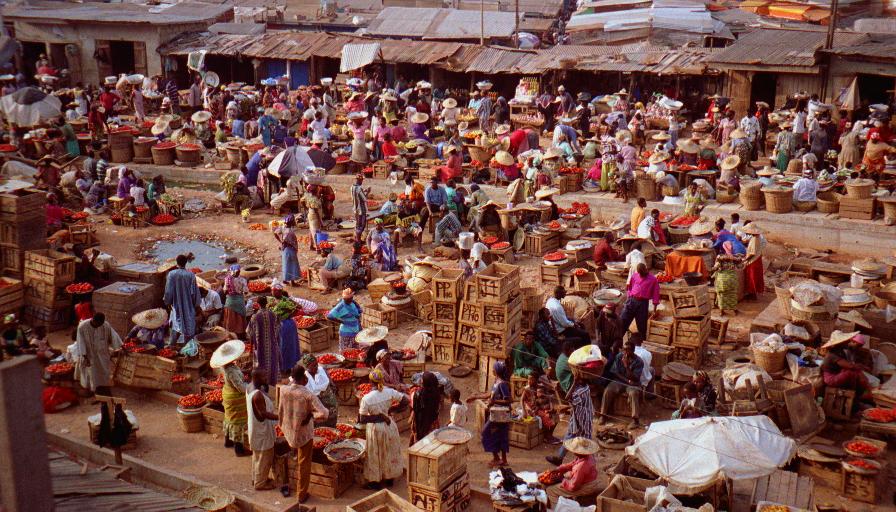Come to the Manger
© 2000 Alcress Communications
One of the interesting parts of our time in Ghana was the regular journey to the Kumasi Market for food for the week. It was quite an adventure as the whole market was roughly one quarter of a mile wide and about a mile long. I have a picture of a similar market here which can give you a little bit of an understanding of what it was like. It was a fascinating place with its array of foods and other products on sale. I could show you where to buy Italian shoes, and where they were made a couple of alleys away. There was colour and noise, but what the pictures do not show is the smell. One missionary described it politely as the third world smell, which was a consequence of a hot climate and open drained sanitation. Added to this in certain parts was the smell of dried fish - called stinking fish or that of meat in the warm African sun.

An enduring image of Christmas is that of the child in the Manger. We tend in our stained glass windows and Christmas Card pictures to sanitise the reality into something that we can handle. Like the market, the smell, the dirt, the darkness are often overlooked because we would prefer not to think about them.
Perhaps we do not have quite the equivalent here, but think about the prospect of giving birth in a shearing shed with the animals in ready for shearing the next day. This is not what you would call the most conducive environment to start a family. It is not the choice that most young couples would make for the all important event. Think of the fuss that is made when a couple fails to get to the hospital and the child is born on the roadside. Think of the fuss if some couple announced that they would like to have the birth in a stable. So we tend to make the stable into a hospital delivery room and sanitise the picture.
We forget that Jesus's family were poor, homeless and refugees fearful of their lives and tend to glamorise them into safe images. And even when these images get to hard to handle, we like to keep at a distance and so we fill Christmas with tinsel and Santas and elves until even the baby disappears from view. It is far easier to talk of a mythical figure that rewards the good and punishes the bad rather that to face the reality that Jesus came to be here to die because we had fallen short of God's expectations for us.
The simple message of Christmas is that God cares. Not only for the rich and nice people, but for the poor and lonely and outcasts as well. Rather than sending a conquering army of angels, God came himself as a baby in the poorest of circumstances. Vulnerable and without resources in order that we might be conquered by love. This baby is the key, for God came as someone to love and not someone to fear. He came to humanity into the bottom strata of society that he might be available and accessible to everyone. Even the announcement of the birth with angelic host was not a national broadcast, but restricted to the simple working folk in the fields watching their sheep.
Sometimes at Christmas, the baby Jesus seems to be so far from the centre of things that we can tend to overlook him entirely. I invite you to come again to the manger and look in at the child that would change the world. Think about the manger in the stable and that baby who would grow into a man who changed the world by the way he died and offered a way back to God for each and every person. This Christmas, take a moment to look for the baby and respond to the love he represents. May you discover God in that child and your Christmas be a time of blessing, hope and joy.
AMEN
.Christmas Eve
Preached at Saundridge, Bracknell and Cressy - December 24, 2000.
Author: Father Andrew Lang.
© 2000 Alcress Communications
Scripture Index | Subject Index | Home | Contact
